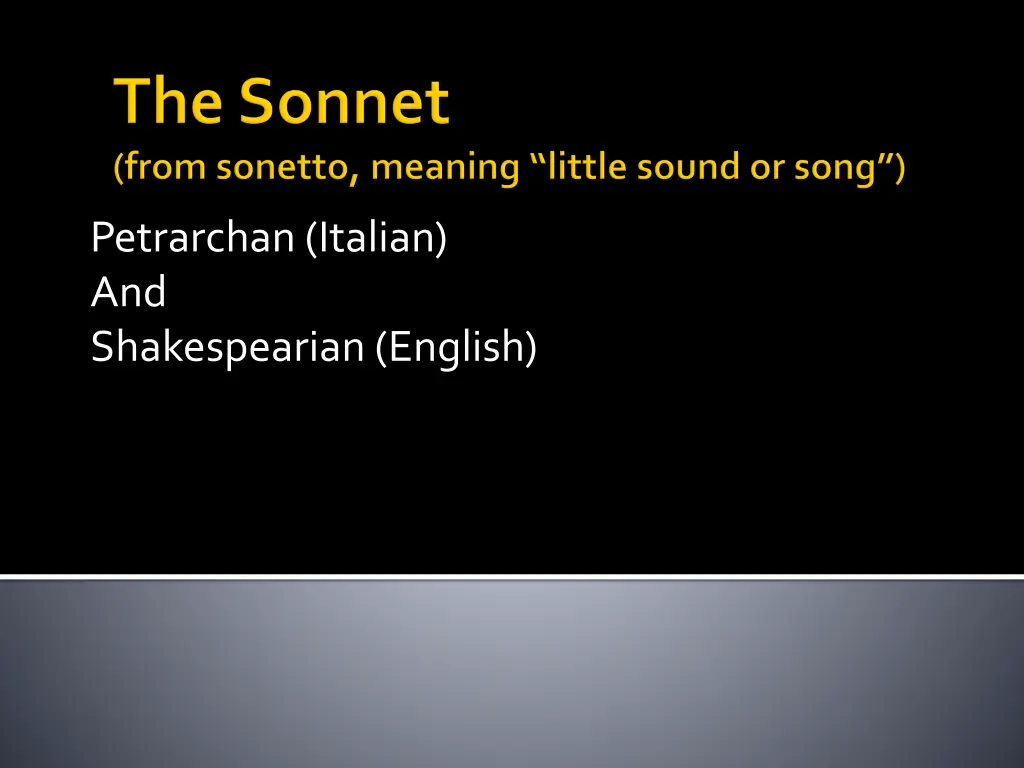
Italian and English Sonnet Forms Comparison
Explore the differences between Petrarchan (Italian) and Shakespearean (English) sonnet forms. Learn about Petrarch's unrequited love for Laura, the structure of 14 lines divided into two stanzas, and the rhyme schemes. Delve into Shakespeare's sonnets with 14 lines in iambic pentameter, divided into four stanzas, leading to a rhyming couplet conclusion. Discover the poetic beauty and distinct characteristics of these classic sonnet forms.
Download Presentation

Please find below an Image/Link to download the presentation.
The content on the website is provided AS IS for your information and personal use only. It may not be sold, licensed, or shared on other websites without obtaining consent from the author. If you encounter any issues during the download, it is possible that the publisher has removed the file from their server.
You are allowed to download the files provided on this website for personal or commercial use, subject to the condition that they are used lawfully. All files are the property of their respective owners.
The content on the website is provided AS IS for your information and personal use only. It may not be sold, licensed, or shared on other websites without obtaining consent from the author.
E N D
Presentation Transcript
Petrarchan (Italian) And Shakespearian (English)
14thcentury Italian poet Francisco Petrarca Head over heals in love with an idealized woman named Laura De Noves, whom he had never actually had a conversation Wrote 366 sonnets to her Key idea: the lover s love for a beautiful, yet unattainable woman is not returned and he (the lover) suffers as if from a bad flu (freezes and burns) Frequent metaphor: love in terms of religion
14 lines Lines are divided into two stanzas The first stanza is an octave (eight lines) in which a problem, observation, question, or some other answerable charge is presented The second stanza is a sestet (six lines) in which there is a turn, or volta, that marks a shift in the direction of the foregoing argument or narrative, turning the sestet into the vehicle for the counterargument, clarification, or whatever answer the octave demands Rhyme Scheme: abba abba cdecde or cdcdcd
Those eyes, 'neath which my passionate rapture rose, The arms, hands, feet, the beauty that erewhile Could my own soul from its own self beguile, And in a separate world of dreams enclose, The hair's bright tresses, full of golden glows, And the soft lightning of the angelic smile That changed this earth to some celestial isle, Are now but dust, poor dust, that nothing knows. And yet I live! Myself I grieve and scorn, Left dark without the light I loved in vain, Adrift in tempest on a bark forlorn; Dead is the source of all my amorous strain, Dry is the channel of my thoughts outworn, And my sad harp can sound but notes of pain.
Generally thought to be the easier of the two to write. 14 lines, 10 syllables per line (iambic pentameter) Lines divided in to four stanzas The first three stanzas are four lines each The final stanza is a rhyming couplet, often called a heroic couplet The couplet plays a pivotal role, usually arriving in the form of a conclusion, amplification, or even refutation of the previous three stanzas, often creating an epiphanic quality to the end Rhyme scheme: abab cdcd efefgg
My mistress' eyes are nothing like the sun; Coral is far more red than her lips' red; If snow be white, why then her breasts are dun; If hairs be wires, black wires grow on her head. I have seen roses damasked, red and white, But no such roses see I in her cheeks; And in some perfumes is there more delight Than in the breath that from my mistress reeks. I love to hear her speak, yet well I know That music hath a far more pleasing sound; I grant I never saw a goddess go; My mistress when she walks treads on the ground. And yet, by heaven, I think my love as rare As any she belied with false compare.
Stanza - a set of lines, quatrain, sestet, octave, couplet Iamb a two syllable measure, unstressed followed by stressed Pentameter a line consisting of five measures Volta a turn or change in theme or tone Heroic couplet a rhyming couplet Conceit - an extended metaphoric comparison that establishes parallels between two seemingly dissimilar things or situations. Petrarch established the practice of including conceits in sonnets by using elaborate comparisons to praise his lady's beauty and portray his own suffering
